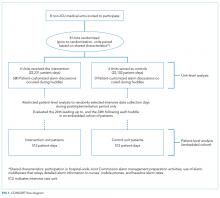Safety Huddle Intervention for Reducing Physiologic Monitor Alarms: A Hybrid Effectiveness-Implementation Cluster Randomized Trial
BACKGROUND: Monitor alarms occur frequently but rarely warrant intervention.
OBJECTIVE: This study aimed to determine if a safety huddle-based intervention reduces unit-level alarm rates or alarm rates of individual patients whose alarms are discussed, as well as evaluate implementation outcomes.
DESIGN: Unit-level, cluster randomized, hybrid effectiveness-implementation trial with a secondary patient-level analysis.
SETTING: Children’s hospital.
PATIENTS: Unit-level: all patients hospitalized on 4 control (n = 4177) and 4 intervention (n = 7131) units between June 15, 2015 and May 8, 2016. Patient-level: 425 patients on randomly selected dates postimplementation.
INTERVENTION: Structured safety huddle review of alarm data from the patients on each unit with the most alarms, with a discussion of ways to reduce alarms.
MEASUREMENTS: Unit-level: change in unit-level alarm rates between baseline and postimplementation periods in intervention versus control units. Patient-level: change in individual patients’ alarm rates between the 24 hours leading up to huddles and the 24 hours after huddles in patients who were discussed versus not discussed in huddles.
RESULTS: Alarm data informed 580 huddle discussions. In unit-level analysis, intervention units had 2 fewer alarms/patient-day (95% CI: 7 fewer to 6 more, P = .50) compared with control units. In patient-level analysis, patients discussed in huddles had 97 fewer alarms/patient-day (95% CI: 52–138 fewer, P < .001) in the posthuddle period compared with patients not discussed in huddles. Implementation outcome analysis revealed a low intervention dose of 0.85 patients/unit/day.
CONCLUSIONS: Safety huddle-based alarm discussions did not influence unit-level alarm rates due to low intervention dose but were effective in reducing alarms for individual children.
TRIAL REGISTRATION: ClinicalTrials.gov identifier: NCT02458872. https://clinicaltrials.gov/ct2/show/NCT02458872
© 2018 Society of Hospital Medicine
Physiologic monitor alarms occur frequently in the hospital environment, with average rates on pediatric wards between 42 and 155 alarms per monitored patient-day.1 However, average rates do not depict the full story, because only 9%–25% of patients are responsible for most alarms on inpatient wards.1,2 In addition, only 0.5%–1% of alarms on pediatric wards warrant action.3,4 Downstream consequences of high alarm rates include interruptions5,6 and alarm fatigue.3,4,7
Alarm customization, the process of reviewing individual patients’ alarm data and using that data to implement patient-specific alarm reduction interventions, has emerged as a potential approach to unit-wide alarm management.8-11 Potential customizations include broadening alarm thresholds, instituting delays between the time the alarm condition is met and the time the alarm sounds, and changing electrodes.8-11 However, the workflows within which to identify the patients who will benefit from customization, make decisions about how to customize, and implement customizations have not been delineated.
Safety huddles are brief structured discussions among physicians, nurses, and other staff aiming to identify and mitigate threats to patient safety.11-13 In this study, we aimed to evaluate the influence of a safety huddle-based alarm intervention strategy targeting high alarm pediatric ward patients on (a) unit-level alarm rates and (b) patient-level alarm rates, as well as to (c) evaluate implementation outcomes. We hypothesized that patients discussed in huddles would have greater reductions in alarm rates in the 24 hours following their huddle than patients who were not discussed. Given that most alarms are generated by a small fraction of patients,1,2 we hypothesized that patient-level reductions would translate to unit-level reductions.
METHODS
Human Subject Protection
The Institutional Review Board of Children’s Hospital of Philadelphia approved this study with a waiver of informed consent. We registered the study at ClinicalTrials.gov (identifier NCT02458872). The original protocol is available as an Online Supplement.
Design and Framework
For our secondary effectiveness outcome evaluating the effect of the intervention on the alarm rates of the individual patients discussed in huddles, we used a cohort design embedded within the trial to analyze patient-specific alarm data collected only on randomly selected “intensive data collection days,” described below and in Figure 1.
Setting and Subjects
All patients hospitalized on 8 units that admit general pediatric and medical subspecialty patients at Children’s Hospital of Philadelphia between June 15, 2015 and May 8, 2016 were included in the primary (unit-level) analysis. Every patient’s bedside included a General Electric Dash 3000 physiologic monitor. Decisions to monitor patients were made by physicians and required orders. Default alarm settings are available in Supplementary Table 1; these settings required orders to change.
All 8 units were already convening scheduled safety huddles led by the charge nurse each day. All nurses and at least one resident were expected to attend; attending physicians and fellows were welcome but not expected to attend. Huddles focused on discussing safety concerns and patient flow. None of the preexisting huddles included alarm discussion.
Intervention
For each nonholiday weekday, we generated customized paper-based alarm huddle data “dashboards” (Supplementary Figure 1) displaying data from the patients (up to a maximum of 4) on each intervention unit with the highest numbers of high-acuity alarms (“crisis” and “warning” audible alarms, see Supplementary Table 2 for detailed listing of alarm types) in the preceding 4 hours by reviewing data from the monitor network using BedMasterEx v4.2 (Excel Medical Electronics). Dashboards listed the most frequent types of alarms, alarm settings, and included a script for discussing the alarms with checkboxes to indicate changes agreed upon by the team during the huddle. Patients with fewer than 20 alarms in the preceding 4h were not included; thus, sometimes fewer than 4 patients’ data were available for discussion. We hand-delivered dashboards to the charge nurses leading huddles, and they facilitated the multidisciplinary alarm discussions focused on reviewing alarm data and customizing settings to reduce unnecessary alarms.







